Hiring the right Talend developers is crucial for organizations looking to optimize their data integration processes. As a recruiter or hiring manager, having a well-crafted set of interview questions can help you identify top talent and ensure you're bringing the best candidates on board.
This blog post provides a comprehensive list of Talend interview questions tailored for various experience levels and areas of expertise. From basic concepts for junior developers to advanced scenarios for senior professionals, we cover a wide range of topics including technical processes, data integration, and situational challenges.
By using these questions, you'll be better equipped to assess candidates' Talend skills and make informed hiring decisions. Consider complementing your interview process with a Talend skills assessment to get a more complete picture of candidates' abilities.
Table of contents
Top 7 Talend questions to ask in interviews
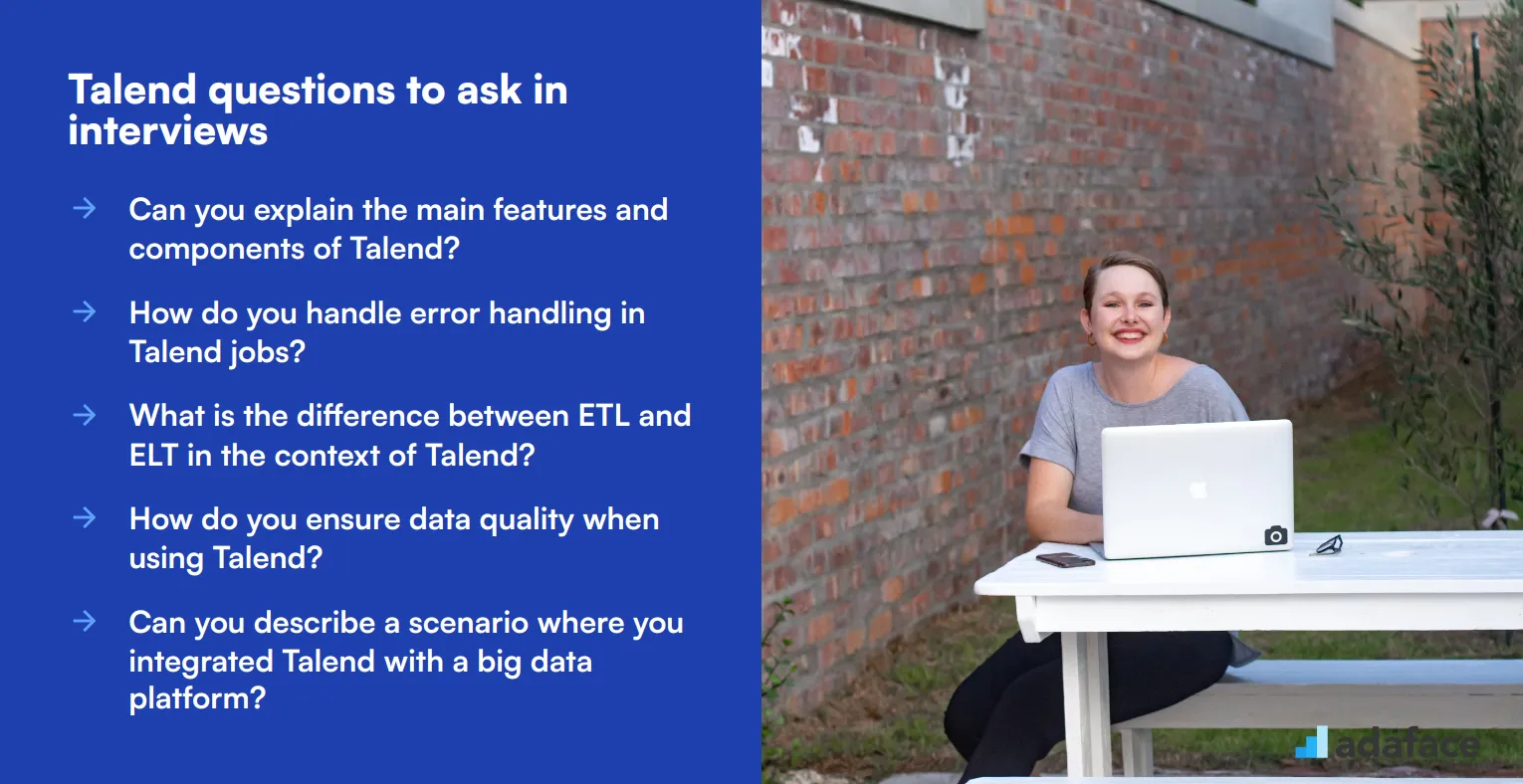
To ensure your candidates are well-versed in Talend, it's essential to ask the right questions. This list of top Talend interview questions will help you evaluate their understanding, problem-solving abilities, and practical knowledge. Use these questions to gauge whether they have the skills required for success in your team.
1. Can you explain the main features and components of Talend?
Talend is an open-source data integration platform. Its main features include data integration, data quality, data preparation, application integration, and big data integration. Talend provides a unified environment for developing, testing, and deploying data integration processes.
Components of Talend include Talend Studio for designing and developing jobs, Talend Administration Center for managing and monitoring jobs, and various connectors for different databases and platforms. Talend also supports big data platforms like Hadoop and Spark.
Look for candidates who can clearly articulate these features and components, showcasing their familiarity with the platform's comprehensive capabilities.
2. How do you handle error handling in Talend jobs?
Error handling in Talend involves using components like tLogCatcher, tDie, and tWarn. The tLogCatcher component captures and logs errors and warnings, while tDie stops the job execution and logs a message. The tWarn component logs a warning message without stopping the job.
Candidates should also mention using try-catch blocks and setting proper error handling strategies within Talend jobs. They might discuss how they set up error handling at different levels, such as component-level, sub-job level, and job level.
Ideal candidates will explain how they implement comprehensive error handling to ensure smooth job execution and quick troubleshooting.
3. What is the difference between ETL and ELT in the context of Talend?
ETL stands for Extract, Transform, Load, where data is extracted from source systems, transformed into a required format, and then loaded into a target system. This process is typically performed outside the target database.
ELT stands for Extract, Load, Transform, where data is extracted and loaded into the target system first, and then the transformation is performed within the target database. This approach leverages the processing power of the database.
Strong candidates should be able to discuss scenarios where each approach is preferable and how Talend supports both ETL and ELT processes.
4. How do you ensure data quality when using Talend?
Ensuring data quality in Talend involves using components like tFilterRow, tMap, tSchemaComplianceCheck, and tUniqRow. These components help with tasks such as filtering out bad data, mapping and transforming data, checking schema compliance, and removing duplicates.
Additionally, Talend Data Quality tools can be used to profile, cleanse, and standardize data. This includes setting up data validation rules, standardizing formats, and enriching data.
Look for candidates who emphasize a structured approach to data quality, including validation, cleansing, and continuous monitoring to maintain high standards.
5. Can you describe a scenario where you integrated Talend with a big data platform?
In a scenario where Talend is integrated with a big data platform like Hadoop, the process typically involves using Talend's big data components like tHDFSInput, tHDFSOutput, tPigLoad, tPigStoreResult, and others. These components allow for data ingestion, processing, and storage within the Hadoop ecosystem.
For instance, a job might involve extracting data from HDFS, transforming it using Pig scripts, and storing the results back into HDFS or another big data storage solution. Talend also supports Spark for in-memory big data processing.
Candidates should illustrate their experience with specific big data platforms and how they leveraged Talend's capabilities to handle large-scale data integration tasks.
6. How do you optimize Talend jobs for better performance?
Optimizing Talend jobs involves several strategies, such as minimizing the use of memory-intensive components, optimizing tMap transformations, using bulk components for database operations, and parallelizing tasks wherever possible.
Candidates might also mention using partitioning and splitting large datasets, tuning JVM settings, and leveraging Talend's built-in performance profiling tools to identify and address bottlenecks.
An ideal response will include practical examples of how candidates have successfully optimized Talend jobs in past projects to improve performance and efficiency.
7. What role does Talend Administration Center (TAC) play in managing Talend jobs?
Talend Administration Center (TAC) is a web-based application that provides centralized management and monitoring of Talend jobs. It allows users to schedule, execute, and monitor jobs, manage user access and permissions, and configure job execution environments.
TAC also offers features like logging and reporting, which help in tracking job performance and identifying issues. It plays a crucial role in ensuring smooth and efficient operation of Talend solutions in a production environment.
Look for candidates who can articulate the importance of TAC in a Talend ecosystem and provide examples of how they have used it to manage and monitor jobs effectively.
20 Talend interview questions to ask junior developers
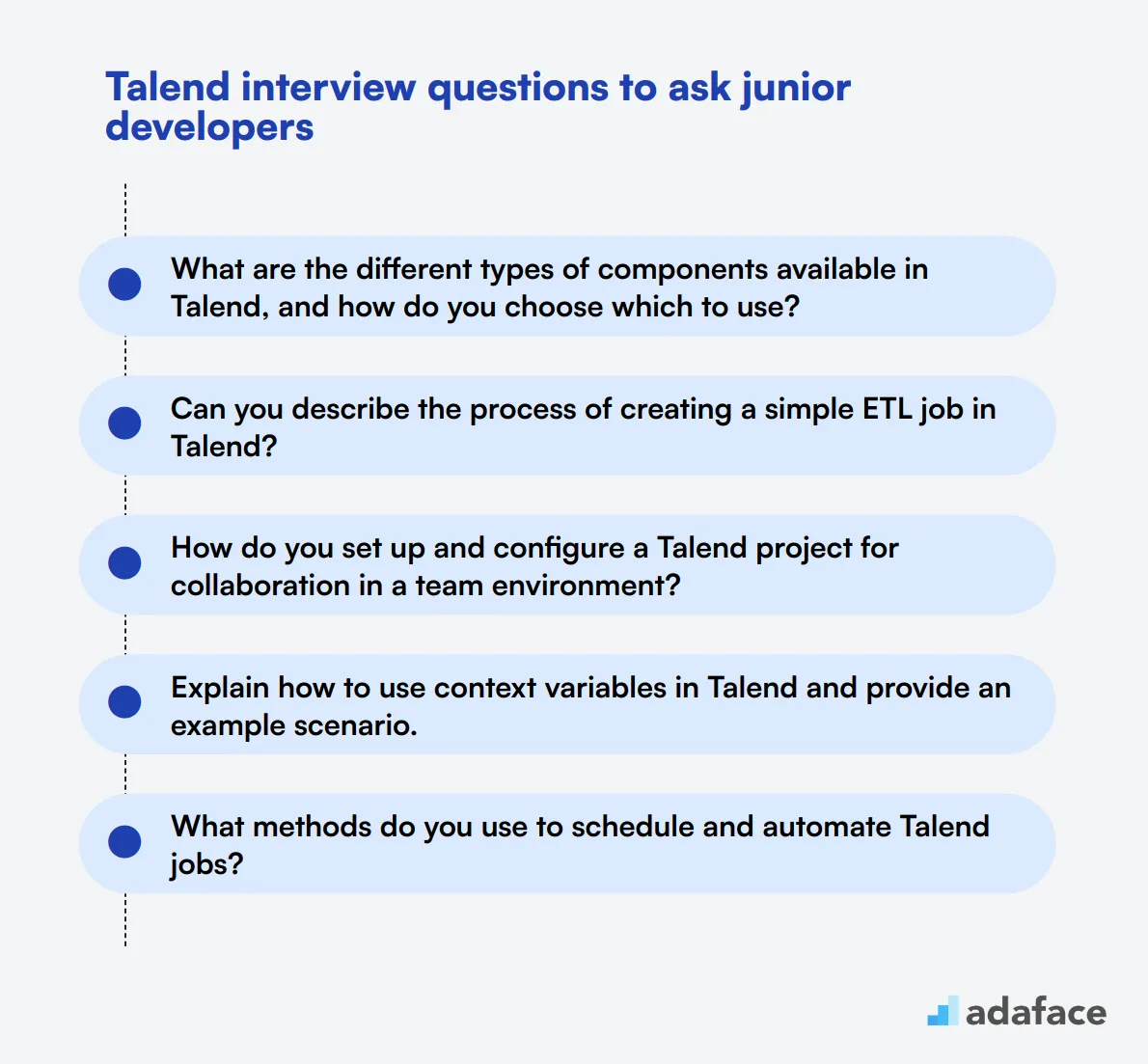
To determine whether your junior developer candidates have the necessary skills and understanding to work effectively with Talend, ask them some of these 20 Talend interview questions. This list will help you evaluate their technical knowledge and practical experience, ensuring they are well-suited for your ETL developer role.
- What are the different types of components available in Talend, and how do you choose which to use?
- Can you describe the process of creating a simple ETL job in Talend?
- How do you set up and configure a Talend project for collaboration in a team environment?
- Explain how to use context variables in Talend and provide an example scenario.
- What methods do you use to schedule and automate Talend jobs?
- How do you handle and manage metadata in Talend?
- Can you explain the process of connecting Talend to different data sources?
- What steps do you take to troubleshoot and debug Talend jobs?
- How do you manage version control and deployment in Talend?
- Describe how you would use Talend to transform and cleanse data.
- What is a tMap component, and how do you use it in Talend jobs?
- How do you handle large datasets in Talend to ensure efficiency and performance?
- Can you explain the role of Talend's code generation feature?
- What strategies do you use for data integration using Talend?
- How do you implement data validation in Talend?
- Describe how you would use Talend to extract, transform, and load data from an XML file.
- What are Talend routines, and how do you use them?
- How do you ensure data encryption and security in your Talend jobs?
- Explain the process of migrating Talend jobs from one environment to another.
- How do you use Talend to integrate data from cloud-based sources?
8 advanced Talend interview questions and answers to evaluate senior developers
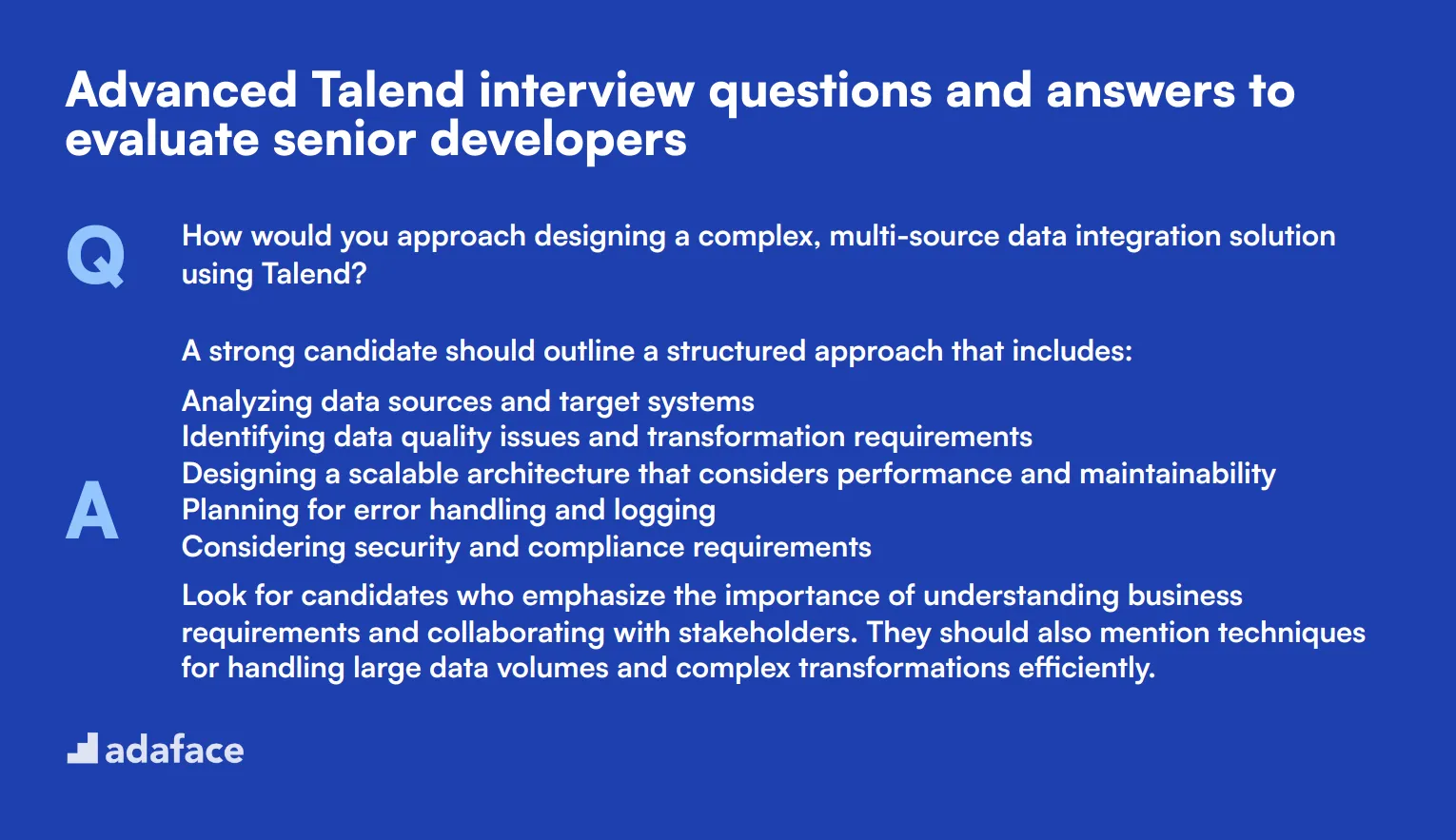
Ready to separate the Talend titans from the novices? These 8 advanced questions will help you identify senior developers who can tackle complex data integration challenges. Use this list to dive deep into a candidate's expertise, uncover their problem-solving skills, and gauge their ability to optimize Talend for enterprise-level projects.
1. How would you approach designing a complex, multi-source data integration solution using Talend?
A strong candidate should outline a structured approach that includes:
- Analyzing data sources and target systems
- Identifying data quality issues and transformation requirements
- Designing a scalable architecture that considers performance and maintainability
- Planning for error handling and logging
- Considering security and compliance requirements
Look for candidates who emphasize the importance of understanding business requirements and collaborating with stakeholders. They should also mention techniques for handling large data volumes and complex transformations efficiently.
2. Can you explain how you would implement slowly changing dimensions (SCD) in Talend?
An experienced Talend developer should be able to describe the implementation of different SCD types:
- Type 1: Overwriting the old value
- Type 2: Creating a new record for each change, with effective dates
- Type 3: Adding new columns to track changes
- Type 6: Combining Types 1, 2, and 3
Pay attention to candidates who discuss the use of specific Talend components like tSCDCombine or custom implementations using tMap and database lookups. They should also mention considerations for performance optimization and handling of large datasets in SCD scenarios.
3. How do you ensure data lineage and traceability in complex Talend jobs?
A proficient Talend developer should discuss multiple strategies:
- Utilizing Talend's built-in metadata management features
- Implementing consistent naming conventions for jobs and components
- Using context variables to track data sources and transformations
- Leveraging Talend Data Catalog for enterprise-wide lineage
- Implementing custom logging mechanisms for detailed transformation tracking
Look for candidates who emphasize the importance of documentation and mention how data lineage contributes to regulatory compliance and facilitates troubleshooting. They should also discuss how they balance the level of detail with performance considerations.
4. Describe a situation where you had to optimize a poorly performing Talend job. What steps did you take?
An experienced candidate should outline a systematic approach to performance optimization:
- Analyzing job logs and execution statistics to identify bottlenecks
- Profiling data to understand volume and distribution
- Optimizing SQL queries and database interactions
- Implementing partitioning and parallel processing
- Utilizing bulk loading techniques where appropriate
- Refactoring job design to reduce unnecessary transformations
Pay attention to candidates who mention the use of Talend's performance monitoring tools and their ability to balance optimization with maintainability. They should also discuss how they validate improvements and ensure that optimizations don't introduce new issues.
5. How would you implement real-time data integration using Talend?
A knowledgeable candidate should discuss various approaches to real-time integration:
- Using Talend ESB for service-oriented architectures
- Implementing change data capture (CDC) techniques
- Leveraging message queues and streaming platforms like Kafka
- Utilizing Talend Data Services for API-based integrations
- Designing event-driven architectures
Look for candidates who can explain the trade-offs between different real-time integration methods and discuss how to handle issues like data consistency and error recovery in real-time scenarios. They should also mention considerations for scaling real-time solutions.
6. How do you approach testing and quality assurance for Talend jobs?
A thorough answer should cover multiple aspects of testing:
- Unit testing individual components and transformations
- Integration testing of complete jobs
- Performance testing under various data volumes
- Regression testing to ensure changes don't break existing functionality
- Automated testing using Talend's CI/CD capabilities
- Data quality checks and validation rules
Evaluate candidates who emphasize the importance of creating repeatable test scenarios and maintaining a test data set. They should also discuss how they incorporate testing into the development lifecycle and handle test data management in compliance with data privacy regulations.
7. How would you design a Talend-based data warehouse solution that can handle both batch and real-time data ingestion?
An experienced candidate should outline a hybrid architecture that accommodates both batch and real-time processing:
- Designing a lambda or kappa architecture
- Using batch jobs for historical data loads and periodic updates
- Implementing real-time ingestion using Talend ESB or streaming solutions
- Creating a unified view of batch and real-time data
- Ensuring data consistency between batch and real-time layers
- Implementing appropriate data governance and quality measures
Look for candidates who discuss the challenges of maintaining consistency across batch and real-time data, and how they would handle late-arriving data or data reconciliation. They should also mention considerations for scalability and how they would optimize for different query patterns in this hybrid environment.
8. How do you manage and version control complex Talend projects in a team environment?
A strong answer should cover both technical and process aspects:
- Using Git or SVN for version control of Talend artifacts
- Implementing branching strategies (e.g., GitFlow) for feature development and releases
- Utilizing Talend's built-in project management features
- Setting up continuous integration and automated builds
- Establishing code review processes and standards
- Managing shared resources and context variables across team members
Evaluate candidates who emphasize the importance of collaboration and communication in team environments. They should discuss strategies for resolving conflicts, managing dependencies between jobs, and ensuring consistency across the project. Look for mentions of documentation practices and how they facilitate knowledge sharing within the team.
12 Talend interview questions about technical processes
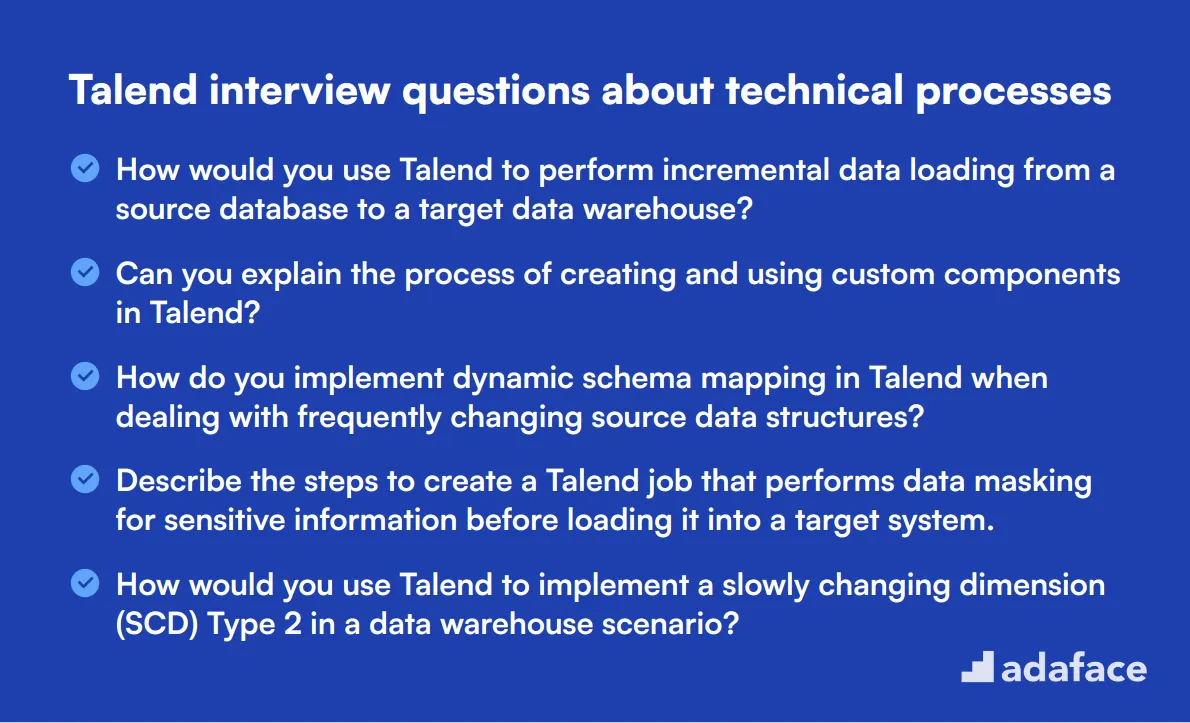
To assess candidates' practical knowledge of Talend's technical processes, use these 12 interview questions. They help evaluate a data engineer's ability to handle complex scenarios and implement efficient solutions using Talend's features.
- How would you use Talend to perform incremental data loading from a source database to a target data warehouse?
- Can you explain the process of creating and using custom components in Talend?
- How do you implement dynamic schema mapping in Talend when dealing with frequently changing source data structures?
- Describe the steps to create a Talend job that performs data masking for sensitive information before loading it into a target system.
- How would you use Talend to implement a slowly changing dimension (SCD) Type 2 in a data warehouse scenario?
- Can you explain how to use Talend for real-time data streaming and processing?
- How do you implement parallel processing in Talend to improve job performance for large datasets?
- Describe the process of creating and using custom routines in Talend to extend its functionality.
- How would you use Talend to perform data reconciliation between two different systems?
- Can you explain how to implement change data capture (CDC) using Talend?
- How do you use Talend to create a master data management (MDM) solution?
- Describe how you would use Talend to implement a data quality firewall for incoming data feeds.
9 Talend interview questions and answers related to data integration
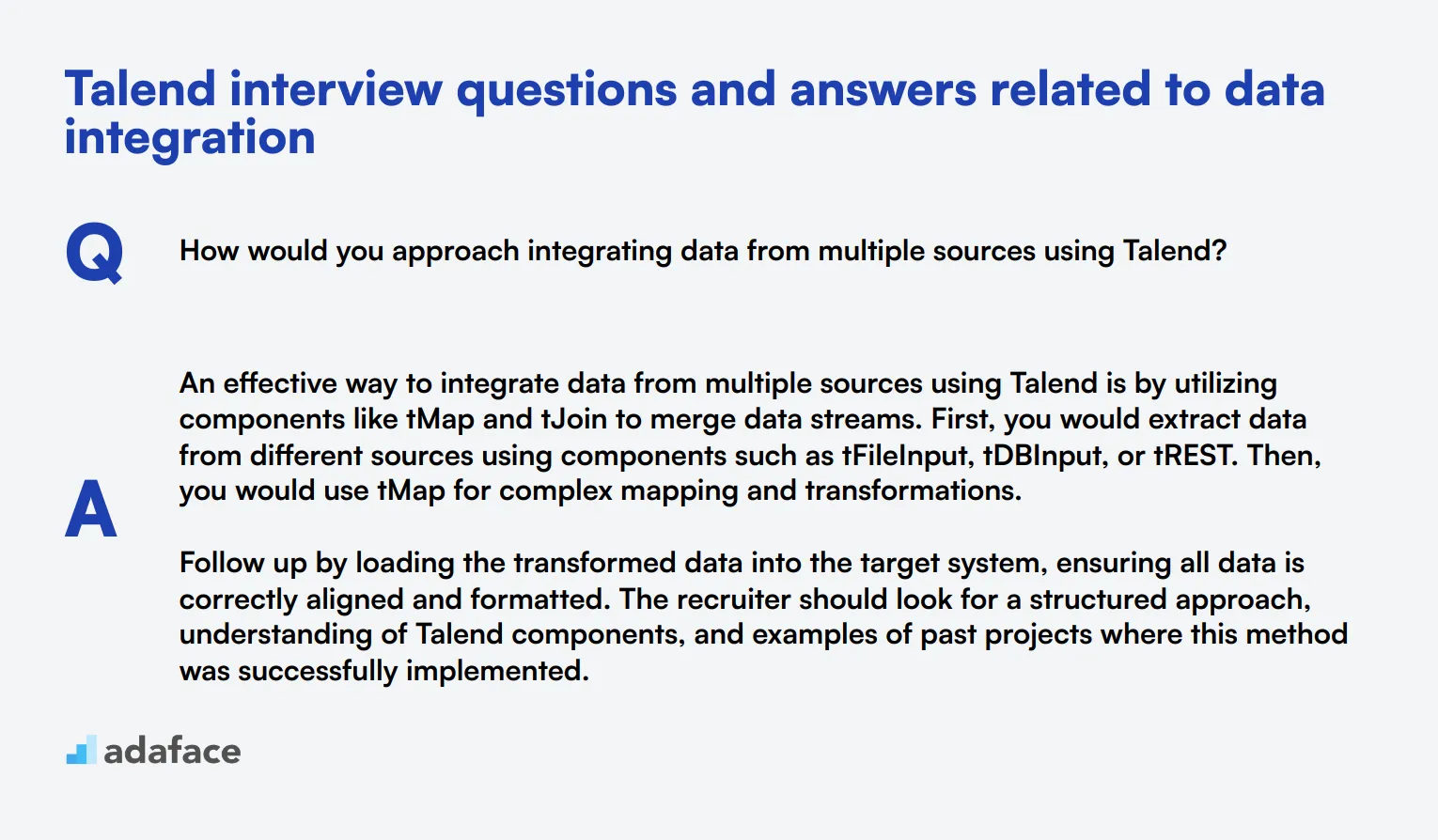
To evaluate whether candidates possess the right skills for data integration using Talend, refer to this curated list of interview questions. These questions are designed to help you gauge their practical understanding and problem-solving abilities in a real-world context.
1. How would you approach integrating data from multiple sources using Talend?
An effective way to integrate data from multiple sources using Talend is by utilizing components like tMap and tJoin to merge data streams. First, you would extract data from different sources using components such as tFileInput, tDBInput, or tREST. Then, you would use tMap for complex mapping and transformations.
Follow up by loading the transformed data into the target system, ensuring all data is correctly aligned and formatted. The recruiter should look for a structured approach, understanding of Talend components, and examples of past projects where this method was successfully implemented.
2. Can you explain how you would use Talend to manage and synchronize data between an on-premise database and a cloud-based system?
To manage and synchronize data between an on-premise database and a cloud-based system, you would typically use Talend's cloud connectors and database components. First, set up connections to both databases using tDBInput for the on-premise database and tCloudInput for the cloud system. Then, utilize tMap to handle data transformations and tDBOutput to load data into the target system.
A good candidate response should include considerations for data consistency, handling conflicts, and scheduling regular synchronization jobs. Look for a detailed explanation of their approach and any challenges they have faced in similar scenarios.
3. What strategies do you use to ensure data quality during the integration process in Talend?
Ensuring data quality during the integration process in Talend involves several strategies. First, use tFilterRow and tSchemaComplianceCheck to validate data formats and filter out invalid records. Second, employ tReplace and tNormalize for data cleansing and standardization. Finally, implement tLogRow and tFileOutput for logging and auditing purposes.
Look for a candidate who emphasizes the importance of setting up validation rules, regular monitoring, and how they handle exceptions. A strong response should demonstrate their proactive approach to maintaining high data quality standards.
4. How do you manage job dependencies and orchestration in Talend?
Managing job dependencies and orchestration in Talend can be effectively handled using tRunJob and tPreJob/tPostJob components. These components allow you to structure your workflows by specifying dependencies and ensuring that jobs run in the correct sequence. Additionally, using Talend Administration Center (TAC) for scheduling and monitoring can streamline the orchestration process.
Ideal candidates should highlight their experience with setting up complex job dependencies and how they use Talend's built-in tools to manage job execution. Look for insights into their problem-solving abilities and how they handle job failures or delays.
5. Describe a scenario where you had to implement a data transformation using Talend. What were the key steps you took?
In a data transformation scenario using Talend, the key steps typically include extracting data using tInput components, transforming data with tMap, and loading it into the target system with tOutput components. For example, if you need to normalize data, you would first extract the raw data, apply transformation rules in tMap, and then load the cleaned data into your desired format.
Evaluate the candidate's ability to clearly articulate each step of the process and how they handle common challenges such as data inconsistencies or performance optimization. Look for specific examples from their experience to validate their understanding.
6. How do you ensure that your Talend jobs are scalable and can handle increasing data volumes?
To ensure Talend jobs are scalable, employ strategies such as partitioning data flows, using efficient components like tParallelize, and optimizing memory usage. Additionally, leverage Talend's built-in tools for monitoring and performance tuning to identify bottlenecks and optimize job execution.
Candidates should demonstrate their understanding of scalability principles and their experience with managing large datasets. Look for examples where they've successfully scaled a Talend job and the specific techniques they used.
7. Can you describe your experience with using Talend for data migration projects?
In data migration projects, Talend is used for extracting data from the source systems, transforming it as needed, and loading it into the target systems. This involves setting up connections to both source and target databases, employing tMap for transformations, and using components like tDBOutput for loading the data.
Evaluate the candidate's ability to discuss specific migration projects they have worked on, the challenges faced, and how they managed data integrity throughout the process. An ideal candidate would provide detailed examples demonstrating their expertise in data migration using Talend.
8. How do you monitor and manage Talend job performance in a production environment?
Monitoring and managing Talend job performance in a production environment involves using Talend Administration Center (TAC) for scheduling, monitoring, and alerting. Additionally, implementing logging and auditing within Talend jobs using tLogCatcher and tFlowMeter can provide insights into job performance and help identify bottlenecks or issues.
Look for candidates who emphasize proactive monitoring, their approach to handling performance issues, and any tools or techniques they use to ensure optimal job performance. Strong candidates will also discuss their experience with performance optimization strategies.
9. What methods do you use to handle incremental data loading in Talend?
Handling incremental data loading in Talend typically involves using techniques such as Change Data Capture (CDC), timestamp-based filtering, or comparing source and target datasets to identify changes. Components like tDBInput and tMap can be configured to filter and process only the new or changed records.
Ideal candidates should explain their approach to setting up incremental loading, including how they ensure data consistency and minimize impact on source systems. Look for specific examples and their ability to adapt these methods to different scenarios.
6 situational Talend interview questions with answers for hiring top developers
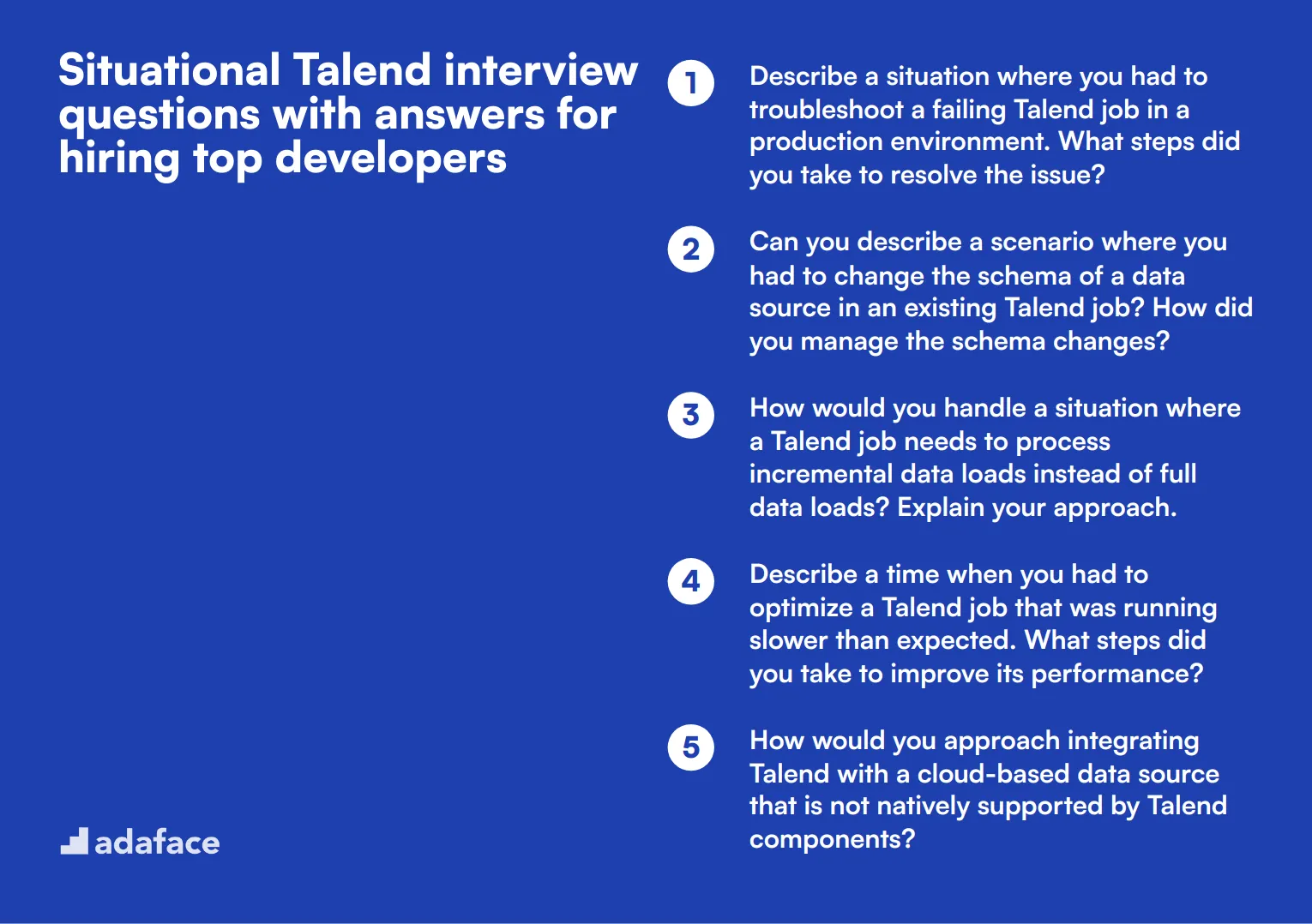
To determine whether your applicants can handle real-world Talend challenges, ask them some of these situational Talend interview questions. These questions will help you gauge their problem-solving abilities and practical knowledge of Talend.
1. Describe a situation where you had to troubleshoot a failing Talend job in a production environment. What steps did you take to resolve the issue?
When troubleshooting a failing Talend job, the first step is to identify the error messages and logs. This can provide clues about the root cause of the failure. Next, I would review the job design and configurations to ensure everything is set up correctly.
Common steps include checking data source connections, verifying component configurations, and ensuring that all required libraries and dependencies are available. If the issue is related to data quality, I would perform data validation checks to pinpoint any problematic records.
An ideal candidate should demonstrate a systematic approach to troubleshooting, highlighting their ability to isolate and resolve issues efficiently. Look for candidates who emphasize thorough analysis and methodical problem-solving.
2. Can you describe a scenario where you had to change the schema of a data source in an existing Talend job? How did you manage the schema changes?
In one project, we had to update the schema of a data source due to changes in the business requirements. To manage this, I first updated the relevant Talend components to reflect the new schema. This involved modifying tMap components, input/output schemas, and any other affected components.
Next, I performed extensive testing to ensure the changes didn't break the existing job logic. I also updated the metadata repository and documented the schema changes for future reference.
Look for candidates who show a clear understanding of the impact of schema changes and who emphasize thorough testing and documentation. This indicates their ability to manage changes without disrupting ongoing processes.
3. How would you handle a situation where a Talend job needs to process incremental data loads instead of full data loads? Explain your approach.
For processing incremental data loads, I would configure the Talend job to only fetch new or modified records since the last load. This can be achieved by using timestamp or version columns in the source tables to filter the data.
I would use a tMap component to manage the logic for identifying new or updated records and ensure that the target tables are updated accordingly. Additionally, I would implement logging and monitoring to track the success of the incremental loads.
An ideal candidate should explain a clear strategy for implementing incremental data loads, emphasizing the importance of filtering and efficient data processing. Look for their ability to articulate how they handle data freshness and integrity.
4. Describe a time when you had to optimize a Talend job that was running slower than expected. What steps did you take to improve its performance?
In a scenario where a Talend job was running slowly, the first step I took was to profile the job to identify bottlenecks. I used Talend's built-in profiling tools to analyze the job's performance and pinpoint slow components.
Common optimization techniques include optimizing SQL queries, parallelizing data processing, and adjusting memory settings for Talend components. I also reviewed the job design to eliminate any unnecessary transformations or data movements.
A strong candidate should demonstrate a methodical approach to optimization, leveraging profiling tools and best practices. Look for their ability to identify specific bottlenecks and implement targeted improvements.
5. How would you approach integrating Talend with a cloud-based data source that is not natively supported by Talend components?
When integrating with a cloud-based data source not natively supported by Talend, I would first look for any available APIs or connectors provided by the cloud service. If such APIs are available, I would use Talend's tREST or tHTTP components to interact with the API.
In cases where the API requires authentication, I would configure the necessary authentication mechanisms within the Talend job. Additionally, I would handle data mapping and transformation within Talend to ensure the data is correctly integrated into the target system.
Look for candidates who demonstrate resourcefulness and a solid understanding of API integration. They should mention the importance of handling authentication and data transformation effectively.
6. Explain a situation where you had to ensure data quality in a Talend job. What steps did you take to validate and cleanse the data?
In a project where data quality was crucial, I implemented several data validation and cleansing steps within the Talend job. This included using tMap and tFilterRow components to filter out invalid records and applying business rules to validate data.
I also used Talend's data profiling tools to analyze the data and identify any anomalies or inconsistencies. For data cleansing, I leveraged components like tReplace, tNormalize, and tDenormalize to standardize and correct the data.
A strong candidate should emphasize the importance of data validation and cleansing, demonstrating their ability to implement effective quality checks. Look for their familiarity with Talend's data profiling and cleansing components.
Which Talend skills should you evaluate during the interview phase?
While it's challenging to fully assess a candidate in one interview, focusing on key Talend skills can give a comprehensive understanding of their expertise. Here, we outline the core skills that are imperative to evaluate for a role involving Talend, to ensure candidates can handle the demands of data integration and management projects effectively.
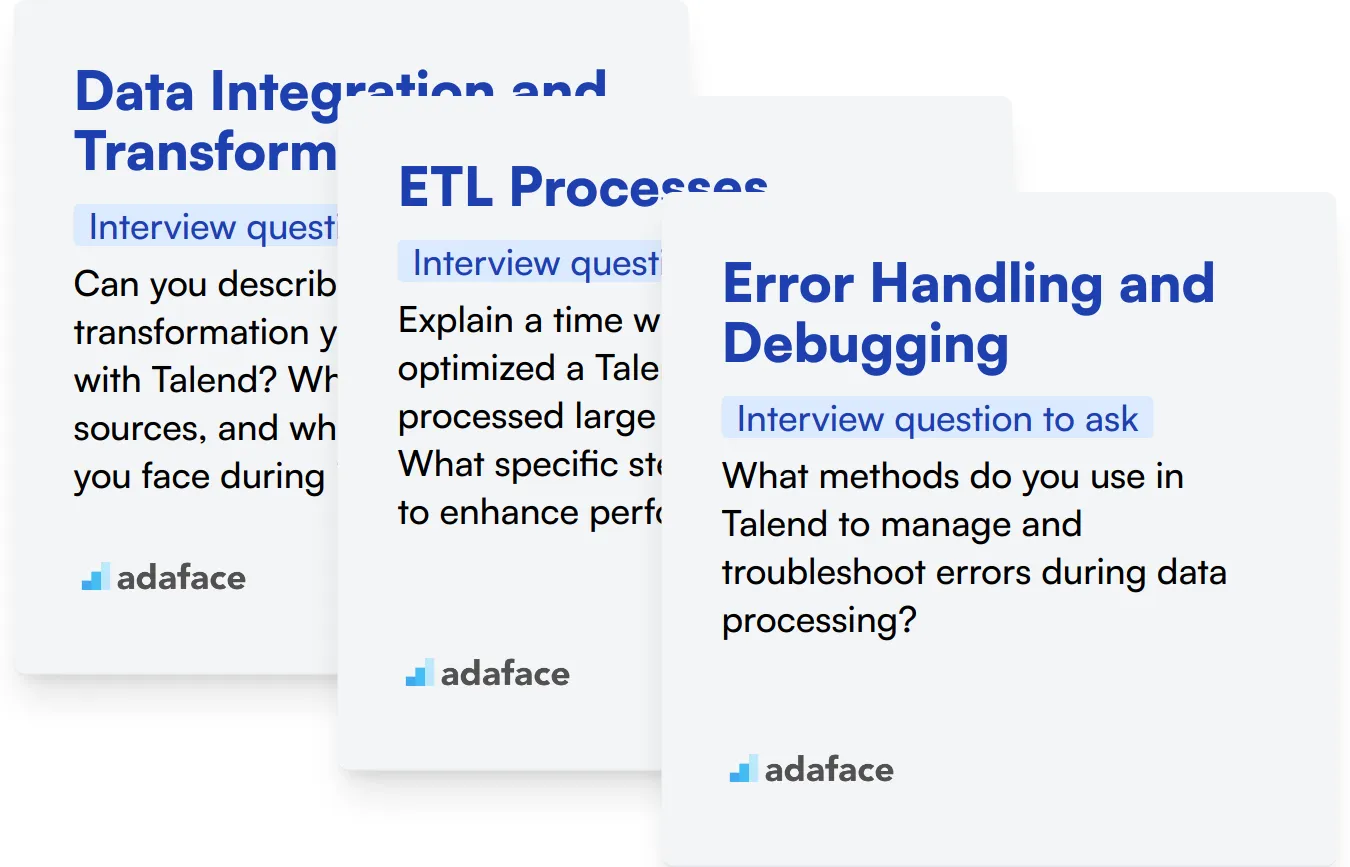
Data Integration and Transformation
Data integration and transformation are at the heart of what makes Talend an effective tool for many organizations. The ability to merge data from diverse sources and transform it into a coherent dataset for analysis is critical for business intelligence and decision-making processes.
To initially screen candidates on their proficiency with data integration, consider using a Talend Online Test. This test includes multiple-choice questions that cover essential data integration scenarios to help identify candidates who are well-versed in these core principles.
In addition to testing, asking targeted interview questions can provide deeper insight into the candidate's practical abilities with Talend's data integration functions.
Can you describe a complex data transformation you've handled with Talend? What were the sources, and what challenges did you face during integration?
Look for detailed answers that showcase a deep understanding of data sources, transformation techniques, and problem-solving skills. The candidate should be able to articulate the steps they took and how they overcame specific integration challenges.
ETL Processes
Understanding ETL (Extract, Transform, Load) processes is fundamental for any developer working with Talend, as it affects how data is prepared and loaded into the system for analysis. This skill is directly linked to the efficiency and reliability of data processing applications developed using Talend.
You might want to explore Talend's capabilities in ETL processing by using an assessment test that focuses on these areas. Unfortunately, there isn't a direct test available in our library for ETL specific to Talend, but general ETL Online Test can be a good start.
Further evaluating their ETL expertise can be achieved through specific interview questions.
Explain a time when you optimized a Talend job that processed large volumes of data. What specific steps did you take to enhance performance?
Effective answers should detail the approach taken, including any modifications to job design or configurations that helped improve performance. The ability to diagnose and enhance ETL workflows is crucial.
Error Handling and Debugging
Error handling and debugging are critical for maintaining the reliability of data flows in Talend. Candidates must demonstrate the ability to quickly identify and rectify issues to ensure data integrity and system efficiency.
Gauging a candidate's capability in this area can be effectively done through pointed interview questions.
What methods do you use in Talend to manage and troubleshoot errors during data processing?
The candidate should discuss specific error handling functions and debugging practices in Talend. Pay attention to their familiarity with log files, rejection flows, and components like tLogCatcher.
Tips for Effective Talend Interview Questions
Before putting your newfound knowledge to use, consider these tips to maximize the effectiveness of your Talend interviews. These suggestions will help you streamline your hiring process and identify the best candidates.
1. Implement Skills Tests Before Interviews
Start by using skills tests to evaluate candidates' Talend proficiency before the interview stage. This approach saves time and ensures you're interviewing candidates with the necessary technical skills.
Consider using a Talend online test to assess core competencies. Additionally, an ETL online test can evaluate broader data integration skills.
These tests provide objective data on candidates' abilities, allowing you to focus interviews on more nuanced aspects of their experience and problem-solving skills. By filtering candidates early, you can dedicate more time to those with proven technical prowess.
2. Curate a Balanced Set of Interview Questions
With limited interview time, it's crucial to select a mix of questions that cover various aspects of Talend expertise. Aim for a balance between technical knowledge, practical experience, and problem-solving abilities.
Include questions about related technologies like SQL and data warehousing to gauge the candidate's overall data integration knowledge. Consider adding a few questions about data modeling to assess their understanding of data structures.
Don't forget to incorporate questions that evaluate soft skills such as communication and teamwork. These are essential for successful integration into your development team.
3. Master the Art of Follow-Up Questions
Asking follow-up questions is key to uncovering a candidate's true depth of knowledge and experience. This technique helps you differentiate between those who have memorized answers and those with genuine understanding.
For example, after asking about Talend's data integration capabilities, follow up with a question about a specific challenge they've faced using these features. Look for detailed, experience-based responses that demonstrate practical application of Talend skills.
Leveraging Talend Skills Tests to Identify Top Talent
When hiring for roles requiring Talend skills, it's important to verify candidates possess the necessary expertise. The most accurate way to assess this is through Talend Online Tests and related assessments like ETL and Data Warehouse tests.
After candidates are evaluated using these tests, the top performers can be shortlisted for interviews. For further screening, consider directing them to the signup page to begin their formal assessment process or explore our pricing plans for more details on available packages.
Talend Online Test
Download Talend interview questions template in multiple formats
Talend Interview Questions FAQs
Ask a mix of technical, process-oriented, data integration, and situational questions to assess candidates' Talend knowledge and practical skills.
Use a combination of interview questions, practical coding exercises, and Talend skills tests to thoroughly assess a candidate's abilities.
Advanced topics include complex data transformations, performance optimization, error handling, and integration with big data technologies.
Present candidates with real-world scenarios and ask them to explain their approach to solving data integration challenges using Talend.

40 min skill tests.
No trick questions.
Accurate shortlisting.
We make it easy for you to find the best candidates in your pipeline with a 40 min skills test.
Try for freeRelated posts
Free resources




